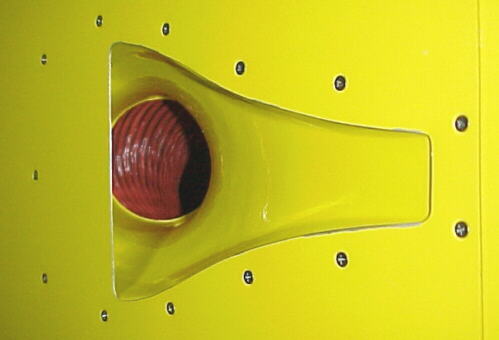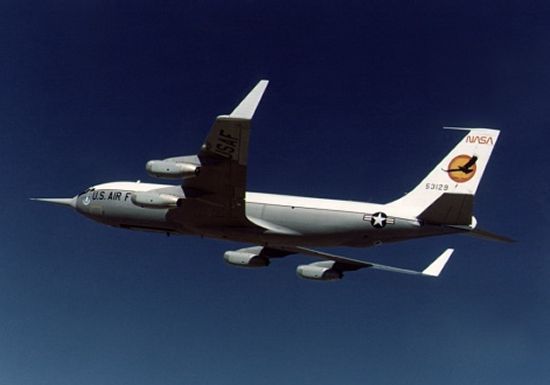Actually, the unpainted booster weight savings was a suggestion from a student, not a decision/idea from team scientists. I’ll have to find the cite but I remember at the time thinking the kid was quite clever.
It may be that research into supersonic flight had an impact. When aircraft started reaching near-supersonic speeds, control was lost due to the leading edge shockwaves deflecting air past the trailing edge control surfaces. This led to control surfaces that include the leading edge (the whole tailplane/elevator moves).
The Saturn V rocket assembly has a small leading nosecone with a flare. Maybe beyond a certain speed the shockwave cavitates the whole rocket, so that drag is a nonissue, and structural considerations are more important.
Si
Most photos of the rockets are too far away to show detail, but look at these pictures from the Saturn V restoration:
Or look at closeups of the Mercury or Gemini capsules, with their angular fronts, weird cross-section changes, and ribbed cpanels. You could say that ribbing gives strength at low weight, but the Apollo capsule has no ribbing on the exterior, and the Gemini and Mercury capsules only have it in certain places. the Saturn V 9as the linked photos show) and the Saturn IIB have ribbing in some places and not in others. And there are a great many protrusions that atren’t evident in these pictures, but which you can see in liftoff photos.
There are also lots of bits near the stage joinings that seem to be related to keeping them together that’s not strreamlined at all (and the ring joining stages is heavily ribbed)
I wondered about that as well. The Shuttle breaks the sound barrier about 45 seconds after launch. I think older rockets accelerated even faster. And lack of airflow on the tail isn’t a problem for rockets because they don’t use control surfaces.
Here’s a Youtube of liftoff. You can see many of the structures I refer to, although I know there’s footage that shows it closer and better:
Here are some photos of an F-14 supersonic fighter jet, you can see just as many protrusions and sharp edges.
blasted Board and/or blasted internet has prevented me from posting this for the past 45 minutes! Sorry if the discussion has advanced beyond it.[SIZE=1]
CM, I think we are overlooking the importance of the role of what I can only describe as the mindset, the psychology, of the early rocket men. They, as do most engineers, desired the “elegant solution”-- the simple, comprehensive solution that resolved all problems. So they tended to envision sleek, coherent, single stage spacecraft as the ultimate, elegant design.
Their “mind’s eye” saw something modeled upon naval ships, capable of individually sailing the galactic seas, as the ultimate goal. Naval vessels require a port, and some degree of supply and support, but are capable of sustaining themselves for the duration of a voyage. They come back to port depleted but otherwise whole-- they don’t discard bits of themselves (“stages”) along the way. I suspect that this implicit vision of a “ship” had influence, if only on a subconscious level. After all, what other icon was available? The parallels between naval ship and space ship are many.
This was probably a self reinforcing loop, with scientists, sci-fi authors, and
illustrators like Bonestell all circling around similar visions.
Of course the actual scientists “knew what specific impulse they had”. But they were searching for ways to increase that net impulse. Design of the rocket motors themselves, but especially research and development of the fuel itself, was ongoing in the early days. They could perform this research using the clumsy cylinders of Peenemunde. But I believe they assumed that, when they finally “got it right”, those self contained, stylistic ships would follow.
Only when research (including fuller understanding of the chemical limitations of exothermic reactions and the depth of earth’s gravity well) made it clear that no such fuel could ever be discovered or created did the mind’s eye view change.
My work system won’t let me open that.
But I believe you.
The question is – why did the early rocket designers think, then, that they needed streamlining? Was it mindset, new findings from research, utilitarian design rather than unnecessary aesthetics, or something else?
Ah, good- my ramble isn’t too dated.
I suspect that, quite frankly, they didn’t “think” much about it at all. Even brilliant people doing innovative research are quite capable of making backgound assumptions that they are unaware of.
A ship is a ship. A ship sails through a medium-- the sea, the air. So a ship is streamlined. No real thought needed. Just historical prejudice.
Damn inadvertant “send”! continued…
Once practical reality caught up, even those assumptions came to be examined. And, upon examination, found wanting. And so the “vision” changed to fit.
For one thing, the V-2 was a single stage design that did not have a detachable payload. That’s an awful lot of weight you’re trying to put into orbit if you’re going to include the whole rocket.
I’m sure if Van Braun had thought of allowing the payload to detach from the missile, V-2s would have threatened more than London.
Again, see note #6. von Braun was pushing streamlined multistage, too.
Part of it may as simple as why movie versions of science labs look nothing at all like real life science labs.
The illustrations were for the public, to boost awareness of and interest in the rocket program. Why not make the models look as great as they could look? The public would probably not accept realistic depictions.
Those early guys were hustlers, forced to scramble for every buck, even after the government got involved. They knew how to play the game.
I know we don’t like to think that’s how science works but it’s real world.
I think it’s a simple matter of form following function. Once rocket designers realized the rockets didn’t need to look like that, they stopped trying to make them look like that.
This:
is a particularly interesting question and may trace its roots to Jules Verne illustrations.
Did you ever see a NACA duct? It’s crappier looking than an air duct you might intuitively think would work. Sorta edgy looking – I’m not sure aerodynamic instinct would dictate that an air scoop should ever be shaped like that.
It’s far from crappy looking, but it is a bit less super round and fluid than one might anticipate.
Winglets are counterintuitive, too.
When it comes to ‘streamlining’ and other things we think are productive in aerodynamics, we overestimate those art deco shapes. In the end, science/data wins. Further, if streamlining like those 50’s rockets made economic sense, it would happed. If there was some return on the investment, bet your butt it’d be done.
http://content.answers.com/main/content/wp/en/thumb/d/d0/200px-NACA_submerged_inlets.JPG
http://www.wrsracing.co.uk/images/yellow%20bonnet%20duct.jpg
Actually, those NACA ducts and winglets look a lot more streamlined and “workable” than the struts, stiffeners, and supports (or whatever they are) on the outsides of the rockets.
I doubt it. The illustratioons are based on Verne’s text, and Verne pretty clearly took his inspiration from projectiles. It was the Baltimore Gun Club, after all, that shot off that craft, and from what was essentially a giant gun. The original projectile was to have been an unmanned sphere (like a musket ball! Or a minie ball), and the addition of a passenger changed it to a literal bullet shape.
Goddard’s rocket looks, I swear, like a metal fourth of July firework, with its conical tin cap and cylinder body (ignoring the conduits to the liquid fuel). I think it was with the American and the German rocket societies’ efforts that you started to get streamlined rockets.
How do you make a smoothly-streamlined multistage rocket? If the whole rocket assembly is streamlined, it’ll bulge out in the middle, then taper again to the back. Now drop off the bottom half of it, and you’ve got something that bulges out, then abruptly ends with a flat bottom, no longer as aerodynamic.
I’m not sure exactly where they fit into this discussion, but no one has mentioned Russian rockets yet. Take a look at this Soyuz.
It certainly works, and is a significantly different design than what the U.S. came up with. Their approach has been to use smaller rocket motors, but more of them, which means the business end has to be a certain size to hold them all. Shows some of the same lack of details streamlining that I think Cal is wondering about. Maybe moreso, the payload at the top (or is that an upper stage) is attached with exposed struts.
I doubt you’ll find a single explanation for all of these protrusions any more detailed than “engineering tradeoffs,” and you’d probably have to track down all of the engineers to get all of those answers. What you’re calling the “ribbed panels” on the Mercury and Gemini capsules (if you mean the corrugated black shingles) are actually heat-radiating fins for reentry; Apollo used a different design. The vertical ribbing along the sides of the rocket I would guess is for strength. This isn’t needed so much along most of the rocket’s length, since the individual stages can have interior bracing (much of it provided by the tanks and plumbing); but the stage joints don’t have any of this internal structure and need all of the strength in a thin ring. I see various protrusions on the Apollo payload shroud that are probably parts of the hinges. The flat front on Gemini may have been required for the docking experiments. (Apollo had a flat front too, for docking with the LEM; they were both covered by aerodynamic shells during liftoff.)
These are all little compromises. I doubt if someone doing a proof-of-concept design would worry about details like exactly how stiff the interstage ring needs to be. It’s not until it turns into a battle of ounces that you have to break out the handbooks and figure all of these little trade-offs out.
It’s also worth noting that the V-2 reached a maximum altitude around 110km - it thus spent most of a flight in the atmosphere. Since range was an issue, attention to aerodynamic drag was appropriate.


